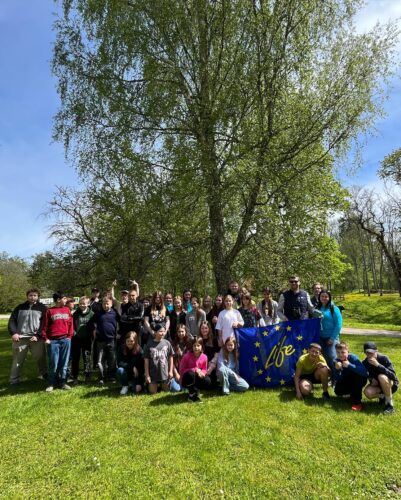To celebrate Natura 2000 Day, students of 5th and 7th grade of Mazsalaca Secondary School took part in an educational…
Within the LIFE IS SALACA project, a training workshop for young rangers of the North Vidzeme Biosphere Reserve (ZBR) Salacgrīva was held on 6 September near the mouth of the river Korģe in Salaca. Young Rangers is an international movement of young people who care about nature. The event brought together 15 students to see with nature experts the restoration of the Salaca’s watercourse, the invertebrates and insects that live in the river, and to learn why such “river weeding” is necessary. One of the tasks of the young rangers on this occasion was to remove the animals from the biomass they found on the river bank and release them back into the river.
The practical work on the Salaca is carried out by the association “Salackrasti Angling Club” in close cooperation with experts in freshwater, fish and invertebrates, thus ensuring that the experts’ recommendations are followed during the work. The young rangers together with invertebrate expert of the Latvian Environment, Geology and Meteorology Centre (LVGMC) Dāvis Ozoliņš, Linda Uzulis from the Nature Conservation Agency (NCA) and Kaspars Abersons from the Institute of Food safety, Animal Health and Environment “BIOR” examined the species of mussels found in the Salaca River: the great water vole, the river toothless toad, as well as various insect representatives: the common water scorpion (Nepa cinerea), dragonfly and damselfly larvae, house crayfish and even a few crustacean individuals such as the sidewinder.
The young people arrived at a time when a caterpillar tractor with a large bucket specially designed for such work was already at work in the river, removing lake rushes and other surface plants that form dense growth and thick root systems. As the river becomes overgrown, its flow rate changes and so do the communities of species living in the river. Salmon, for example, like a gravelly, pebbly river bed, which is good for spawning. The more the river becomes overgrown, the fewer such spawning grounds there are and the fewer salmon there are.
The excavator bucket is designed to leave as much of the substrate (pebbles, stones and gravel) characteristic of fast-flowing streams as possible in the river bed. It should be noted that the chain excavator is equipped with biodegradable oils, thus ensuring that no substances harmful to the river inhabitants will enter the Salaca during the cleaning operations.
The Salaca River is rocky during this year’s restoration work and the teeth of the tractor bucket will wear very quickly. “They are melting like butter and in the first week of work we have already put in a new set of teeth”, says Atis Apelis from Salackrastu, who works with the tractor and cleans the river on a daily basis.
The restoration work on the streams in the LIFE IS SALACA project started at the end of August this year and will continue until 15 September. The work includes restoring suitable habitats for salmonids by removing surface vegetation and the root systems it forms.





